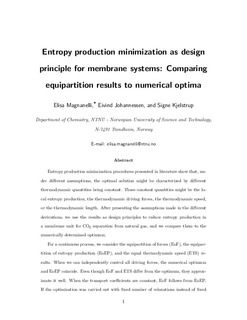| dc.description.abstract | Entropy production minimization procedures presented in literature show that under different assumptions the optimal solution might be characterized by different thermodynamic quantities being constant. These constant quantities might be the local entropy production, the thermodynamic driving forces, the thermodynamic speed, or the thermodynamic length. After presenting the assumptions made in the different derivations, we use the results as design principles to reduce entropy production in a membrane unit for CO2 separation from natural gas, and we compare them to the numerically determined optimum. For a continuous process, we consider the equipartition of forces (EoF), the equipartition of entropy production (EoEP), and the equal thermodynamic speed (ETS) results. When we can independently control all driving forces, the numerical optimum and EoEP coincide. Even though EoF and ETS differ from the optimum, they approximate it well. When the transport coefficients are constant, EoF follows from EoEP. If the optimization was carried out with fixed number of relaxations instead of fixed length of the membrane unit, then the thermodynamic speed would be constant in the optimal case. When the thermodynamic driving forces cannot be controlled independently, neither of the equipartition results characterizes the optimal solution. However, EoEP and ETS approximate it well. Since EoEP and ETS give good approximations of (or coincide with) the numerical optimum independently of the type of control, they can be used as design principles to reduce entropy production in membrane systems. However, using an equipartition result as a design principle will generally not give one and only one solution, and some equipartitioned designs may be far from the optimum. For a discrete process, we considered the EoEP and the equal thermodynamic length (ETL) results. In this case, EoEP gives the best approximation of the optimum. Since the process is not an equilibration process, ETL does not coincide with the optimum, but it still approximates it well. | nb_NO |
